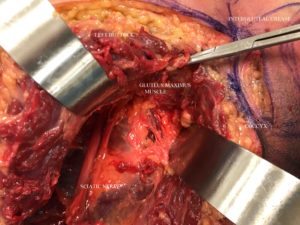Buttock implants are the alternative to fat grafting for buttock augmentation. Their placement is a choice between putting the implant on top of the muscle or inside the gluteus maximus muscle. Because it is an easier tissue plane to develop and a more direct approach to implant placement, on top of the muscle or subfascial placement is the most common pocket location used.
Despite the ‘ease’ of subfascial placement, the better biologic location for buttock implants is in the intramuscular location. As a general rule, the deeper any aesthetic implant is placed in the body the better. The more tissue that exists between the implant and the outer skin the less likelihood there is for complications. (e.g., zeroma, infection, displacement). But unlike breast implants which can be totally placed under the muscle, such is not the case for buttock implants. A complete submuscular placement would put the implant on top the sciatic nerve which has its obvious disadvantages.

In making the intramuscular pocket it is important to be at least 2 cm to 2.5 cms deep into the muscle. The thickness of the gluteus maximums muscle is significant (5 to 6 cms) and the most common tendency is to make the muscle depth too shallow. This can result secondarily in muscle atrophy and the implant ending up in the subfascial location. Knowing the actual thickness of the muscle allows the surgeon to safely make the intramuscular pocket with an adequate overlying muscle layer.
Dr. Barry Eppley
Indianapolis, Indiana


